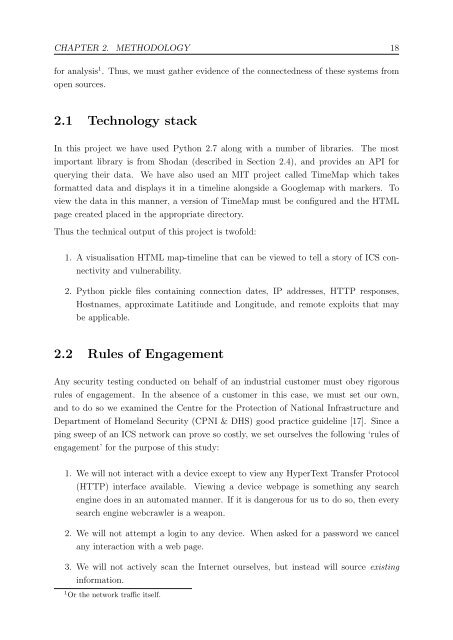Quantitatively Assessing and Visualising Industrial System Attack Surfaces
Quantitatively Assessing and Visualising Industrial System Attack Surfaces
Quantitatively Assessing and Visualising Industrial System Attack Surfaces
Create successful ePaper yourself
Turn your PDF publications into a flip-book with our unique Google optimized e-Paper software.
CHAPTER 2. METHODOLOGY 18<br />
for analysis 1 . Thus, we must gather evidence of the connectedness of these systems from<br />
open sources.<br />
2.1 Technology stack<br />
In this project we have used Python 2.7 along with a number of libraries. The most<br />
important library is from Shodan (described in Section 2.4), <strong>and</strong> provides an API for<br />
querying their data. We have also used an MIT project called TimeMap which takes<br />
formatted data <strong>and</strong> displays it in a timeline alongside a Googlemap with markers. To<br />
view the data in this manner, a version of TimeMap must be configured <strong>and</strong> the HTML<br />
page created placed in the appropriate directory.<br />
Thus the technical output of this project is twofold:<br />
1. A visualisation HTML map-timeline that can be viewed to tell a story of ICS con-<br />
nectivity <strong>and</strong> vulnerability.<br />
2. Python pickle files containing connection dates, IP addresses, HTTP responses,<br />
Hostnames, approximate Latitiude <strong>and</strong> Longitude, <strong>and</strong> remote exploits that may<br />
be applicable.<br />
2.2 Rules of Engagement<br />
Any security testing conducted on behalf of an industrial customer must obey rigorous<br />
rules of engagement. In the absence of a customer in this case, we must set our own,<br />
<strong>and</strong> to do so we examined the Centre for the Protection of National Infrastructure <strong>and</strong><br />
Department of Homel<strong>and</strong> Security (CPNI & DHS) good practice guideline [17]. Since a<br />
ping sweep of an ICS network can prove so costly, we set ourselves the following ‘rules of<br />
engagement’ for the purpose of this study:<br />
1. We will not interact with a device except to view any HyperText Transfer Protocol<br />
(HTTP) interface available. Viewing a device webpage is something any search<br />
engine does in an automated manner. If it is dangerous for us to do so, then every<br />
search engine webcrawler is a weapon.<br />
2. We will not attempt a login to any device. When asked for a password we cancel<br />
any interaction with a web page.<br />
3. We will not actively scan the Internet ourselves, but instead will source existing<br />
information.<br />
1 Or the network traffic itself.



